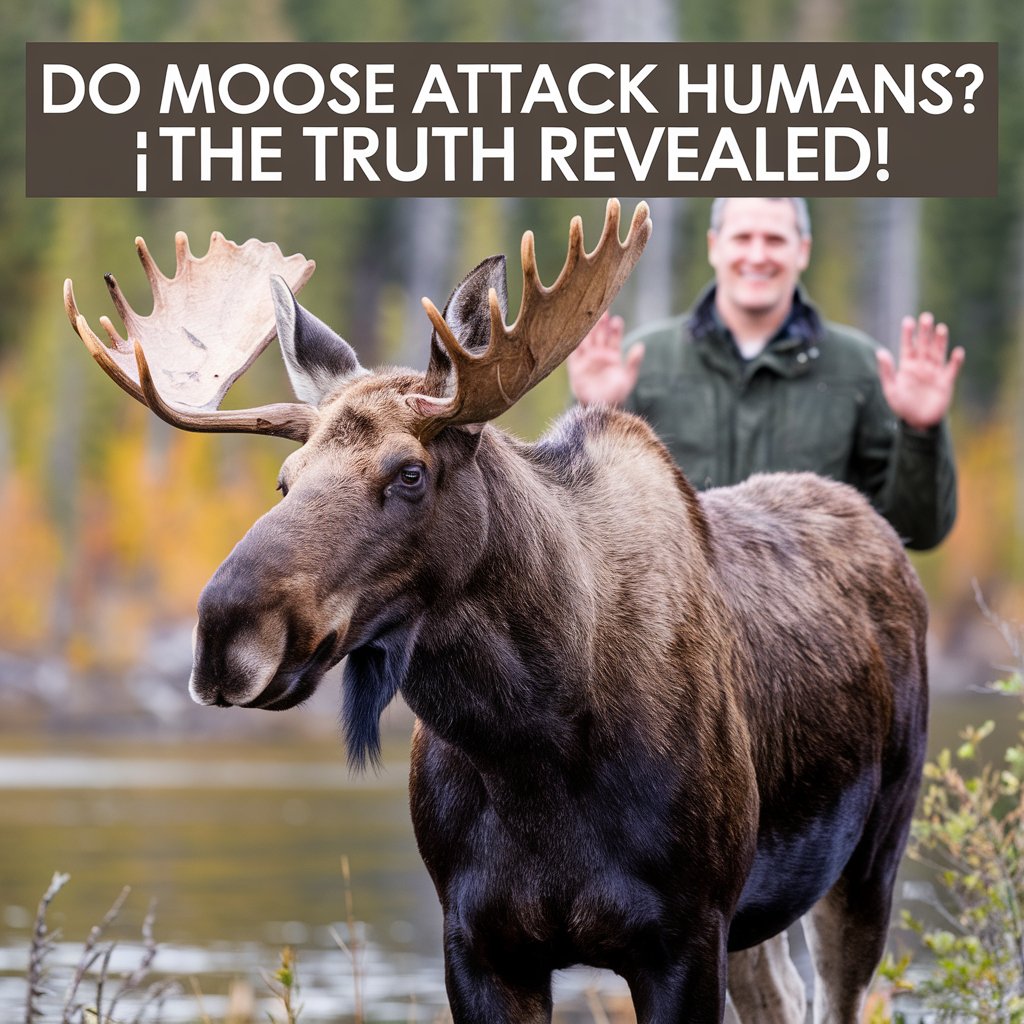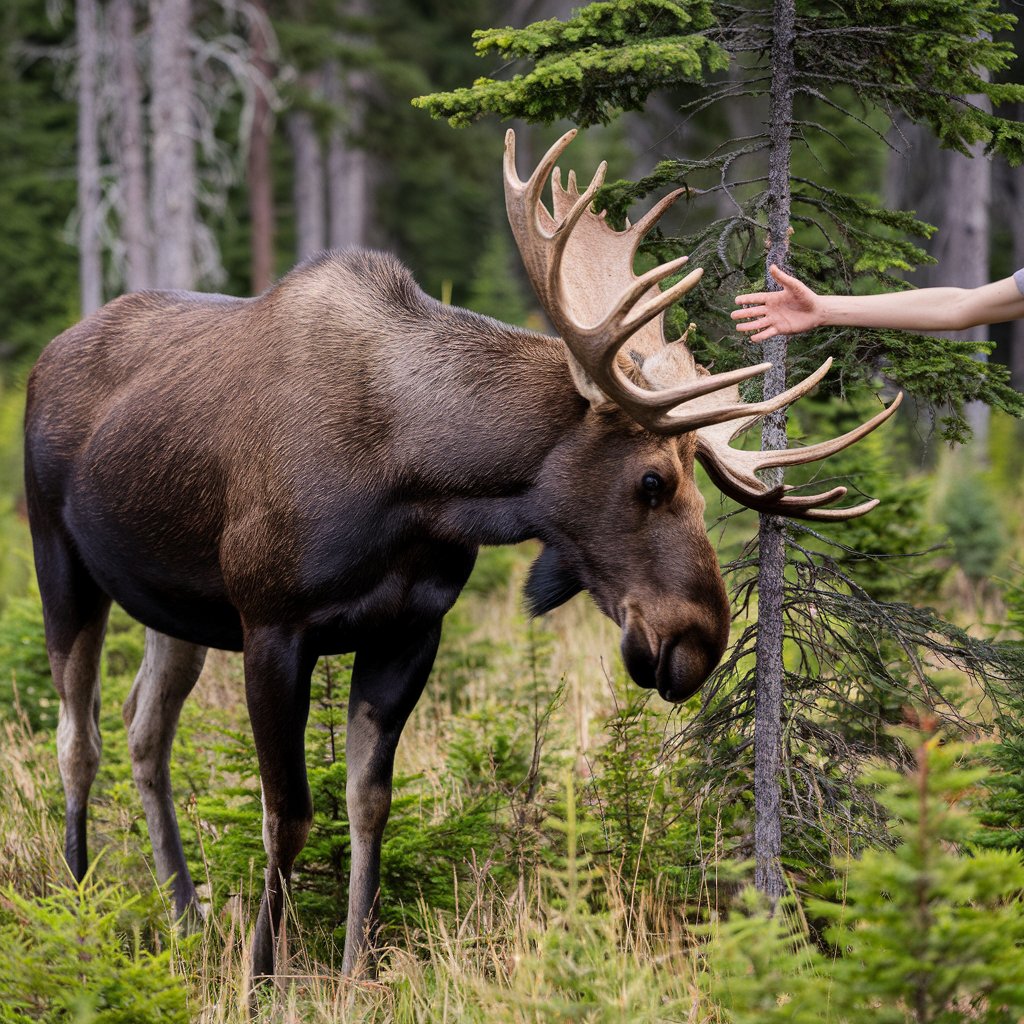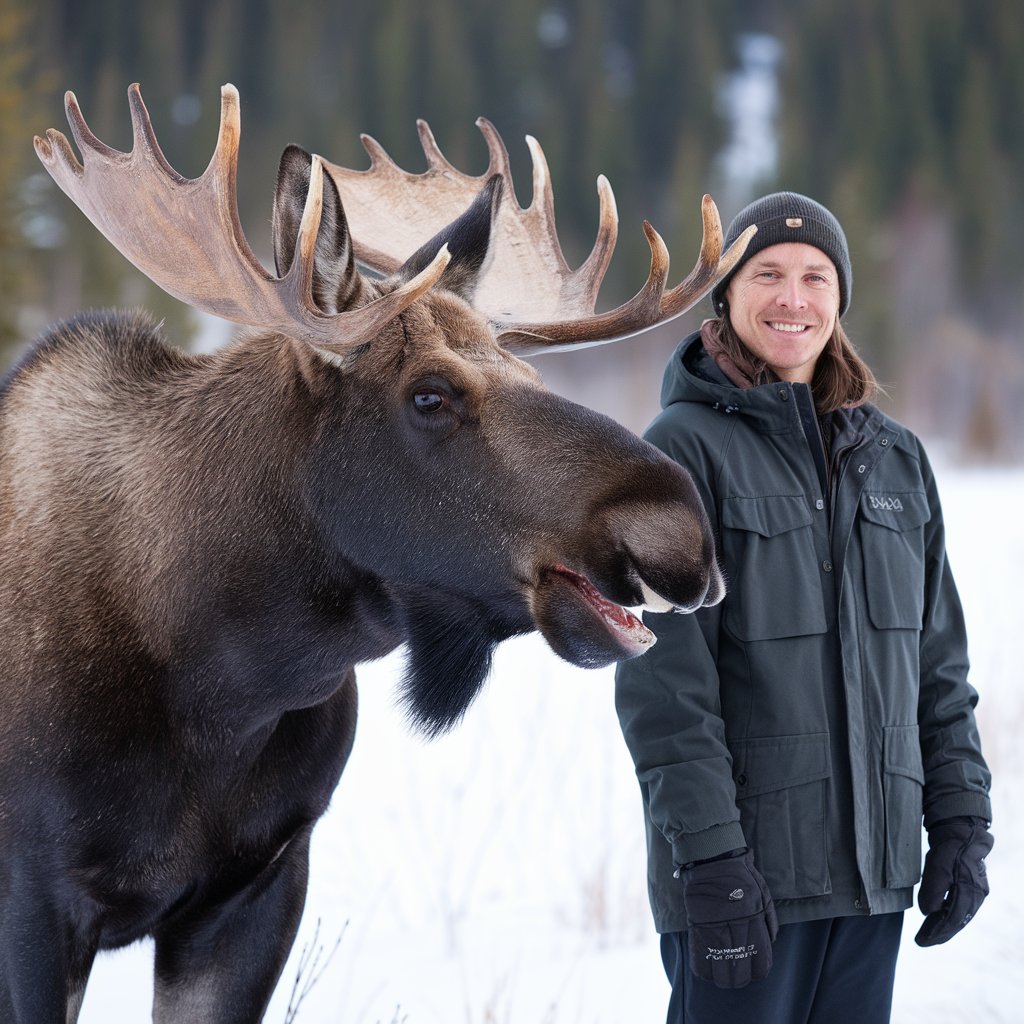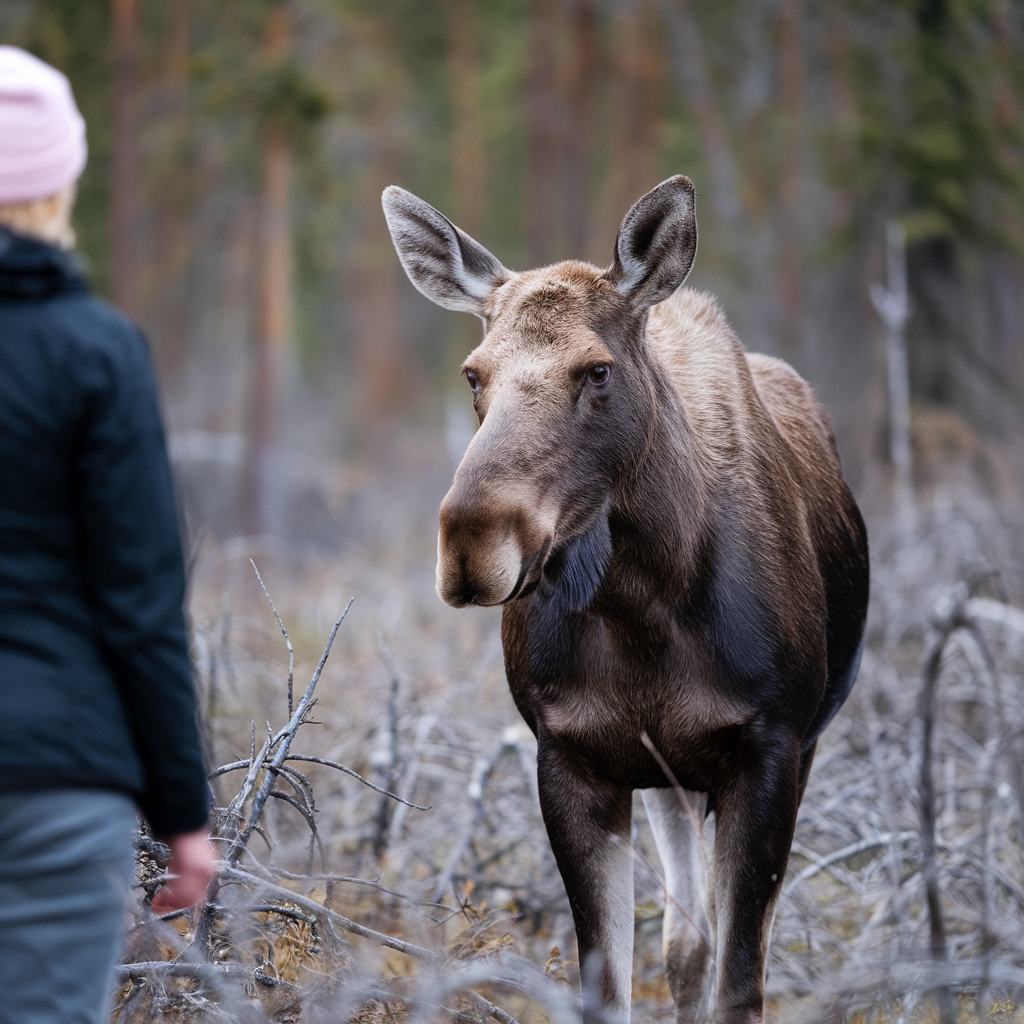Moose, with their towering height, long legs, and impressive shovel-shaped antlers, are among the most iconic wildlife species of North America. Often spotted wandering through Alaska, Canada, and parts of the northeastern United States, these majestic creatures command respect due to their size and strength. However, a question that often arises among outdoor enthusiasts, hikers, and campers is: Do moose attack humans?
While moose are generally calm and peaceful, they are not without the potential for aggression—especially when they feel threatened. In this post, we’ll dive into the behaviors that lead to moose attacks, the physical risks involved, and how you can avoid becoming a victim of an encounter.
Here’s a table summarizing the key facts and figures from the article:
| Fact/Figure | Details |
|---|---|
| Moose Height (at the shoulder) | Up to 6.5 feet tall for males |
| Moose Weight | Between 900 to 1,500 pounds |
| Moose Antler Span | Can span up to 6 feet |
| Moose Speed (Charging) | Up to 35 miles per hour |
| Moose Calf Birth Season | Late spring to early summer |
| Moose Rut (Mating Season) | September to October |
| Moose Attack Statistics (Alaska) | 10 to 20 reported injuries per year due to moose attacks |
| Recommended Distance for Safety | At least 300 feet from moose |
| Moose Warning Signs | Pinned-back ears, raised hackles, stomping, tense posture |
| Moose Feeding Preferences | Leaves, twigs, shrubs |
| Moose Habitat | Boreal forests, temperate zones, marshes, lakes, rivers |
| Moose in North America (Regions) | Alaska, Canada, Maine, Minnesota, Montana, Wyoming |
| Moose Charging Speed | Fast enough to outrun humans |
| Moose Physical Traits | Long slender legs, bulbous nose, large hooves |
| Moose’s Most Aggressive Period | During the rut and when protecting calves |
What Are Moose? A Closer Look at North America’s Largest Deer
Before we dive into the specifics of moose behavior and why they might attack, it’s essential to understand just what these creatures are and what makes them so imposing.
Physical Features of Moose
Moose, scientifically named Alces alces, belong to the deer family but stand apart from other deer species due to their massive size and distinct features. A male moose (bull) can weigh as much as 1,500 pounds, and the females (cows) can weigh up to 1,100 pounds. These animals can stand up to 6.5 feet tall at the shoulder and grow to lengths of 10 feet from head to tail. What makes them so unique?
- Antlers: Male moose grow shovel-shaped antlers, which can span up to 6 feet in width. These antlers are used primarily during the rut, or mating season, to challenge other males for dominance.
- Hooves: The moose’s hooves are large and splayed, allowing them to move through marshy, snow-covered, and swampy terrain with ease.
- Dewlap (Bell): The dewlap, or the long hanging skin under the chin, is particularly prominent in bulls. It adds to their imposing appearance and is believed to help regulate body temperature in cold climates.
- Bulbous Nose and Large Legs: The moose’s bulbous nose is an essential part of its anatomy, helping it to forage effectively. The long, slender legs allow the moose to move easily through snow and dense forest.

Habitat and Distribution of Moose
Moose are found in North America, specifically in regions such as Canada, Alaska, and parts of the northeastern United States (e.g., Maine, Minnesota, Montana, Wyoming). They also inhabit parts of Europe and Asia. Moose are typically found in boreal forests, wetlands, and temperate zones, preferring lakes, rivers, and marshes. These regions offer a wide range of plant life, which moose feed on, as well as plenty of cover.
In Alaska and Canada, moose are often spotted wandering through snow-covered landscapes and deep forests, where they are well adapted to the cold. Moose are solitary animals, usually found alone or in small groups, especially during the non-mating season.
Why Do Moose Attack Humans? Exploring the Reasons Behind Aggression
While moose may appear docile, they can quickly become aggressive when they feel threatened. Understanding the reasons behind moose attacks can help prevent encounters from escalating into dangerous situations.
Defensive Behavior
Moose are prey animals in the wild and have evolved to be naturally defensive. While they don’t typically hunt or attack other animals, they will react aggressively when they feel threatened or cornered. If a moose perceives a human as a threat, it might charge, stomp, or attempt to escape by running away.
Common situations that could lead to moose aggression include:
- Surprise encounters: If a person sneaks up on a moose or appears too close to it, especially when the moose is startled.
- Encroaching on territory: Moose are territorial animals, and during the mating season, their aggression can be heightened as they defend their space.
Signs of a defensive moose include:
- Pinned-back ears: This is a clear sign of aggression.
- Raised hackles: The hair on their neck may stand up if they are feeling threatened.
- Tense posture: Moose will stand very still if they feel threatened, preparing to charge if they feel they need to defend themselves.
- Stomping: They may begin stomping their hooves if they are irritated or agitated.
Mating Season Aggression (Rut)
The mating season, also known as the rut, runs from September to October. During this period, male moose (bulls) become significantly more aggressive due to increased hormonal levels. Bulls use their antlers to challenge other males, often engaging in fierce battles to assert dominance over territory and potential mates.
This territorial behavior extends beyond other moose. Bulls may become defensive of their space and perceive humans as intruders, triggering an aggressive response. During the rut, bulls can be much more unpredictable, and their aggression can lead to dangerous encounters with unsuspecting humans.
Calf Protection
Mother moose, or cows, are incredibly protective of their calves, particularly during late spring and early summer, when calves are born. If a mother perceives a threat to her young, she will not hesitate to act aggressively to protect them. This can include charging or trampling. Even a hiker who unknowingly gets too close to a calf could provoke a defensive reaction from the mother.
The presence of calves is one of the most potent triggers for moose aggression. A mother moose will go to great lengths to ensure the safety of her calf, and human presence near her calf can be perceived as a direct threat.

Human Actions That Trigger Aggression
While moose are not inherently aggressive, humans can unknowingly provoke them. Common human actions that increase the risk of a moose attack include:
- Feeding moose: This alters their natural behavior and causes them to associate humans with food. This can lead to moose becoming more comfortable around people, increasing the likelihood of an aggressive encounter.
- Startling or surprising a moose: Especially in dense woods or areas with low visibility, humans can inadvertently get too close to a resting or feeding moose. The sudden presence of a human can startle the moose and cause it to react defensively.
- Getting too close: Moose may perceive humans as threats if they get within a certain range, even if they are not intentionally trying to provoke the animal.
Are Moose Attacks Dangerous? Understanding the Physical Threat
The physical threat posed by moose should not be underestimated. Their size and strength make them capable of inflicting serious injuries on humans, especially when they are startled or defending their calves.
Physical Threats from Moose
Moose attacks are not common, but when they do occur, they can lead to significant injury. Some of the physical threats include:
- Kicking: Moose have powerful hind legs, and when threatened, they can deliver crushing kicks. These kicks can easily break bones and cause internal injuries.
- Charging: Moose can charge at speeds of up to 35 miles per hour, which makes it nearly impossible for a human to outrun them.
- Trampling: When a moose feels threatened, it may try to trample its perceived attacker, using its long legs and hooves to deliver powerful blows.
Due to their towering height and muscular build, moose can cause substantial damage. In rare cases, moose attacks have led to fatalities, though these incidents are not frequent. The risk of fatality often increases if the individual is unable to escape the charge or if a person falls and is trampled.
Statistics on Moose Attacks
While moose attacks are relatively rare, they do happen. In fact, moose-related injuries have increased in certain regions, particularly in areas like Alaska, Canada, and the northeastern United States. According to wildlife reports, there have been 10-20 moose-related injuries per year, especially in regions like Maine and Minnesota where moose encounters are more common.
In the Alaska region, moose-related fatalities are uncommon but not unheard of. Most injuries are the result of surprise attacks, especially during the rut or when a calf is nearby.
How to Avoid Moose Attacks: Practical Safety Tips
Understanding how to avoid an encounter and knowing what to do during an attack are essential for staying safe in moose habitats. Here’s how to reduce the risks.
Recognize Warning Signs
The first step in avoiding a moose attack is recognizing the warning signs. Moose are not typically aggressive unless provoked, but they will react defensively if they feel threatened. Here are the main signs to watch out for:
- Pinned-back ears: When a moose is agitated or angry, its ears will flatten against its head.
- Raised hackles: A defensive moose will raise the hair along its neck.
- Tense body language: A moose preparing to defend itself will have a stiff, rigid posture.
- Stomping: Moose will stomp their feet if they feel threatened or irritated.
If you notice any of these signs, it’s crucial to back away slowly without making sudden movements. Avoid facing the animal directly, and don’t attempt to run.
Maintain a Safe Distance
The general recommendation is to maintain at least 300 feet of distance from moose. During the rut or when calves are present, increase that distance if possible. Moose may tolerate human presence from a distance, but getting too close—whether for a photo opportunity or simply curiosity—puts both you and the moose at risk.

Avoid Moose Habitats During M
ating Season
If you are in moose habitats during the rut (typically September to October), be especially cautious. Bulls are more aggressive, and encounters during this time can quickly escalate. Avoid areas known for high moose populations during these months, especially if you’re not familiar with the area.
What to Do if a Moose Charges
In the event of a moose charge, follow these steps to increase your chances of survival:
- Do not run: Moose are faster than humans and can easily catch up to you.
- Find shelter: Get behind a large tree, boulder, or any other solid object that could block the moose’s path.
- Get into a vehicle: If a moose is charging and a vehicle is nearby, get inside as quickly as possible.
- Protect vital areas: If knocked down, try to protect your head and chest.

FAQs
1. Are moose aggressive to people?
Moose are generally not aggressive but can become dangerous if provoked, especially during mating season or if a mother feels threatened.
2. What should you do if you encounter a moose?
Stay calm, speak softly, and slowly back away while watching for signs of aggression, like flattened ears and raised hair.
3. Has a human ever ridden a moose?
Yes, historically, some people have ridden moose, with plans to use them in military contexts, such as in Sweden during the 18th century.
4. What does it mean when a moose looks at you?
If a moose stares at you and shows signs like raised hair and ears back, it may be feeling threatened and could act aggressively.
5. Is it safe to touch a moose?
It’s not safe to touch a moose; while they are usually calm, they can become dangerous if they feel provoked or cornered.
6. How powerful is a moose?
Bull moose are incredibly powerful, weighing up to 1,600 pounds and possessing strong muscles and thick skin that help them during fights.
7. How long will a moose chase you?
Moose typically move away after a short time, but they might chase for half an hour if they feel threatened, especially if startled.
8. What happens if a moose sees you?
When a moose sees you, it may either move away to avoid danger or, if threatened, become aggressive to drive you away.
9. Why do moose chase you?
Moose may chase people if they are harassed, feel cornered, or are stressed, particularly in harsh winter conditions.
10. Can a moose be a pet?
Moose are wild animals and should not be kept as pets, even if they appear tame at times, as they can be dangerous.
11. Have humans ever ridden bears?
Some historical accounts mention humans riding bears, but such occurrences are extremely rare and not a common practice.
12. Can a moose outrun a human?
Moose can run up to 35 miles per hour, making it impossible for humans to outrun them if they decide to charge.
13. Are moose friendly or aggressive?
While moose are typically not aggressive, they are not afraid of humans and can become dangerous if provoked.
14. What to do if a moose chases you?
If a moose chases you, try to hide behind a large object like a tree, or if you’re knocked down, curl into a ball and protect your head.
15. What is the lifespan of a moose?
Moose typically live to around 7-8 years, although some may live longer, rarely reaching their late teens or early 20s.
16. Are moose intelligent?
Moose display intelligence, especially as calves, being curious, mischievous, and loyal when raised in human care.
17. Is Moose Jaw safe to live?
Moose Jaw offers a safe and family-friendly environment with a mix of historical charm and modern amenities.
18. What is the biggest threat to moose?
Moose face significant threats from climate change, diseases, and tick infestations, which harm their health and habitat.
19. Do moose run fast?
Moose can run at speeds of up to 35 miles per hour, despite their bulky size, and can swim at a steady pace for hours.
20. How long is a moose pregnant?
Moose have a gestation period of about 243 days, with calves born in late spring or early summer.
21. What do moose eat?
Moose are herbivores, feeding on twigs, bark, roots, and aquatic plants like willows, pondweed, and water lilies.
22. Can you walk up to a moose?
It’s important to keep a safe distance from moose, staying at least 50 feet away and never approaching them.
23. Do people eat moose meat?
Moose meat is nutritious and safe to eat, often considered a healthy alternative to beef, though organs like liver may contain contaminants.
24. How big are moose compared to humans?
Moose can reach over 7 feet in height, making them much taller than the average human, though not as tall as the tallest recorded human.
25. What to do if a moose attacks?
If a moose attacks, try to run to safety or get behind a solid object like a tree, and if knocked down, curl into a ball and stay still.
26. What is the largest moose ever recorded?
The largest recorded moose was a male Alaska moose, standing at 7.5 feet tall and weighing about 820 kg.
27. Are moose afraid of humans?
Moose are not naturally afraid of humans and often tolerate their presence, making them curious and likely to approach people.

Final Verdict: Should You Worry About Moose Attacks?
Moose are fascinating and magnificent creatures, but their size and power mean they should be respected. While moose attacks on humans are rare, they can be serious, especially when the animal feels threatened or is protecting its territory or calves. By learning to read moose body language, maintaining a safe distance, and following the safety guidelines mentioned above, you can greatly reduce your risk of an encounter.
So, should you worry about moose attacking humans? The short answer is: not necessarily, but always exercise caution and respect when in moose territory. By being aware of their behavior and remaining vigilant, you can enjoy observing these incredible animals from a safe distance.
Read more knowledgeable blogs on Flowy Magazine

James Clair is a passionate writer and researcher with a deep fascination for animal behavior and its intricate connection to human life. With a background in [relevant field of study, e.g., zoology, psychology, ethology], James has spent years studying the natural world, focusing on how animals’ actions and instincts impact human emotions, behavior, and society.
His expertise in [specific topics or regions of focus, e.g., canine psychology, animal communication, wildlife conservation] has led to numerous published works and collaborations with renowned researchers and institutions. Through his work at Flawy Magazine, James aims to bridge the gap between scientific research and public understanding, offering insightful, accessible articles that explore the complex relationship between humans and animals.
When he’s not writing, James enjoys [personal hobbies or interests, e.g., hiking in nature, volunteering at animal shelters, photography] and is an advocate for [cause or charity related to animals or conservation]. His mission is to inspire readers to see animals not just as companions or creatures of the wild, but as beings whose behavior holds valuable lessons for us all.









